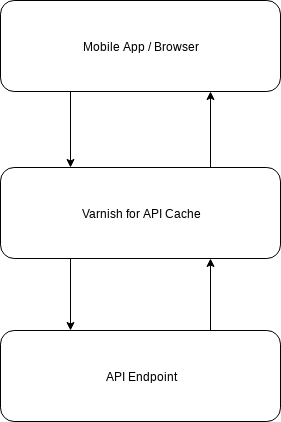API Cache Engine with Varnish
API Cache Solution with Varnish 4.0
Requirements
- API Backend
- Varnish

Mobile App (or) Browser
We can access the cached API’s with host name https://api.example.com from Mobile app or any other client application. Varnish Server
Varnish 4.0 is installed and configured with the following configuration file.
We can configure How much storage Varnish can use in /etc/varnish/varnish.params with VARNISH_STORAGE variable. Eg: VARNISH_STORAGE=”malloc,1G”
Find the default.vcl file.
#
# This is an example VCL file for Varnish.
#
# It does not do anything by default, delegating control to the
# builtin VCL. The builtin VCL is called when there is no explicit
# return statement.
#
# See the VCL chapters in the Users Guide at https://www.varnish-cache.org/docs/
# and http://varnish-cache.org/trac/wiki/VCLExamples for more examples.
# Marker to tell the VCL compiler that this VCL has been adapted to the
# new 4.0 format.
vcl 4.0;
# Default backend definition. Set this to point to your content server.
backend default {
.host = "HOSTNAME/IP";
.port = "80";
}
sub vcl_recv {
# Happens before we check if we have this in cache already.
#
# Typically you clean up the request here, removing cookies you don't need,
# rewriting the request, etc.
#Set backend hostname to your origin hostname
if (req.http.host ~ "REQUIRED_CACHED_API_DOMAIN_NAME") {
set req.http.host = "API_BACKEND_DOMAIN_NAME";
}
# Only cache GET and HEAD requests (pass through POST requests).
if (req.method != "GET" && req.method != "HEAD") {
return (pass);
}
# Return to hash for the following API Requests (Look to Cache for the following requests)
if (req.url ~ "^/API_URL_ONE" ||
req.url ~ "^/API_URL_TWO" ||
req.url ~ "^/API_URL_THREE" ||
req.url ~ "^/API_URL_FOUR" ||
req.url ~ "^/API_URL_FIVE" ||
req.url ~ "^/API_URL_SIX" ) {
return (hash);
}
else {
return (pass);
}
}
sub vcl_backend_response {
# Happens after we have read the response headers from the backend.
#
# Here you clean the response headers, removing silly Set-Cookie headers
# and other mistakes your backend does.
##API CACHE TTL CONFIG ##
# Cache below APIs for 8 Hours
if (bereq.url ~ "^/API_URL_ONE" ||
bereq.url ~ "^/API_URL_TWO" ) {
unset beresp.http.set-cookie;
set beresp.http.cache-control = "public, max-age=300";
set beresp.ttl = 8h;
return (deliver);
}
# Cache below APIs for 5 Hours
if (bereq.url ~ "^/API_URL_THREE" ||
bereq.url ~ "^/API_URL_FOUR") {
unset beresp.http.set-cookie;
set beresp.http.cache-control = "public, max-age=300";
set beresp.ttl = 5h;
return (deliver);
}
# Cache below APIs for 1 Hour
if (bereq.url ~ "^/API_URL_FIVE" ||
bereq.url ~ "^/API_URL_SIX" ){
unset beresp.http.set-cookie;
set beresp.http.cache-control = "public, max-age=300";
set beresp.ttl = 1h;
return (deliver);
}
}
sub vcl_deliver {
# Happens when we have all the pieces we need, and are about to send the
# response to the client.
#
# You can do accounting or modifying the final object here.
}
API Backend
API Backend should be configured to serve on 80 (HTTP).
We can add more API’s which needed to be cached in default.vcl file and define particular cache ttl.